Input interpretation

FeCl_3 (iron(III) chloride) + HI (hydrogen iodide) ⟶ HCl (hydrogen chloride) + I_2 (iodine) + FeCl_2 (iron(II) chloride)
Balanced equation
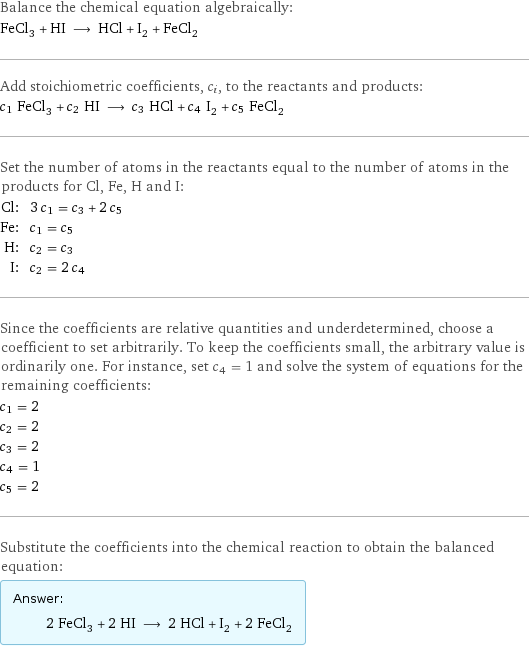
Balance the chemical equation algebraically: FeCl_3 + HI ⟶ HCl + I_2 + FeCl_2 Add stoichiometric coefficients, c_i, to the reactants and products: c_1 FeCl_3 + c_2 HI ⟶ c_3 HCl + c_4 I_2 + c_5 FeCl_2 Set the number of atoms in the reactants equal to the number of atoms in the products for Cl, Fe, H and I: Cl: | 3 c_1 = c_3 + 2 c_5 Fe: | c_1 = c_5 H: | c_2 = c_3 I: | c_2 = 2 c_4 Since the coefficients are relative quantities and underdetermined, choose a coefficient to set arbitrarily. To keep the coefficients small, the arbitrary value is ordinarily one. For instance, set c_4 = 1 and solve the system of equations for the remaining coefficients: c_1 = 2 c_2 = 2 c_3 = 2 c_4 = 1 c_5 = 2 Substitute the coefficients into the chemical reaction to obtain the balanced equation: Answer: | | 2 FeCl_3 + 2 HI ⟶ 2 HCl + I_2 + 2 FeCl_2
Structures

+ ⟶ + +
Names

iron(III) chloride + hydrogen iodide ⟶ hydrogen chloride + iodine + iron(II) chloride
Reaction thermodynamics
Enthalpy
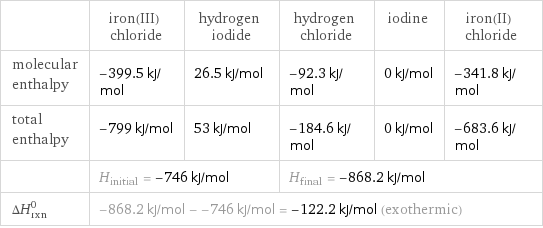
| iron(III) chloride | hydrogen iodide | hydrogen chloride | iodine | iron(II) chloride molecular enthalpy | -399.5 kJ/mol | 26.5 kJ/mol | -92.3 kJ/mol | 0 kJ/mol | -341.8 kJ/mol total enthalpy | -799 kJ/mol | 53 kJ/mol | -184.6 kJ/mol | 0 kJ/mol | -683.6 kJ/mol | H_initial = -746 kJ/mol | | H_final = -868.2 kJ/mol | | ΔH_rxn^0 | -868.2 kJ/mol - -746 kJ/mol = -122.2 kJ/mol (exothermic) | | | |
Gibbs free energy
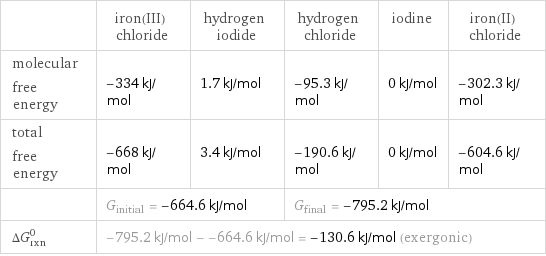
| iron(III) chloride | hydrogen iodide | hydrogen chloride | iodine | iron(II) chloride molecular free energy | -334 kJ/mol | 1.7 kJ/mol | -95.3 kJ/mol | 0 kJ/mol | -302.3 kJ/mol total free energy | -668 kJ/mol | 3.4 kJ/mol | -190.6 kJ/mol | 0 kJ/mol | -604.6 kJ/mol | G_initial = -664.6 kJ/mol | | G_final = -795.2 kJ/mol | | ΔG_rxn^0 | -795.2 kJ/mol - -664.6 kJ/mol = -130.6 kJ/mol (exergonic) | | | |
Equilibrium constant
![Construct the equilibrium constant, K, expression for: FeCl_3 + HI ⟶ HCl + I_2 + FeCl_2 Plan: • Balance the chemical equation. • Determine the stoichiometric numbers. • Assemble the activity expression for each chemical species. • Use the activity expressions to build the equilibrium constant expression. Write the balanced chemical equation: 2 FeCl_3 + 2 HI ⟶ 2 HCl + I_2 + 2 FeCl_2 Assign stoichiometric numbers, ν_i, using the stoichiometric coefficients, c_i, from the balanced chemical equation in the following manner: ν_i = -c_i for reactants and ν_i = c_i for products: chemical species | c_i | ν_i FeCl_3 | 2 | -2 HI | 2 | -2 HCl | 2 | 2 I_2 | 1 | 1 FeCl_2 | 2 | 2 Assemble the activity expressions accounting for the state of matter and ν_i: chemical species | c_i | ν_i | activity expression FeCl_3 | 2 | -2 | ([FeCl3])^(-2) HI | 2 | -2 | ([HI])^(-2) HCl | 2 | 2 | ([HCl])^2 I_2 | 1 | 1 | [I2] FeCl_2 | 2 | 2 | ([FeCl2])^2 The equilibrium constant symbol in the concentration basis is: K_c Mulitply the activity expressions to arrive at the K_c expression: Answer: | | K_c = ([FeCl3])^(-2) ([HI])^(-2) ([HCl])^2 [I2] ([FeCl2])^2 = (([HCl])^2 [I2] ([FeCl2])^2)/(([FeCl3])^2 ([HI])^2)](../image_source/48eea1401afc1dd61139ad03382c4eff.png)
Construct the equilibrium constant, K, expression for: FeCl_3 + HI ⟶ HCl + I_2 + FeCl_2 Plan: • Balance the chemical equation. • Determine the stoichiometric numbers. • Assemble the activity expression for each chemical species. • Use the activity expressions to build the equilibrium constant expression. Write the balanced chemical equation: 2 FeCl_3 + 2 HI ⟶ 2 HCl + I_2 + 2 FeCl_2 Assign stoichiometric numbers, ν_i, using the stoichiometric coefficients, c_i, from the balanced chemical equation in the following manner: ν_i = -c_i for reactants and ν_i = c_i for products: chemical species | c_i | ν_i FeCl_3 | 2 | -2 HI | 2 | -2 HCl | 2 | 2 I_2 | 1 | 1 FeCl_2 | 2 | 2 Assemble the activity expressions accounting for the state of matter and ν_i: chemical species | c_i | ν_i | activity expression FeCl_3 | 2 | -2 | ([FeCl3])^(-2) HI | 2 | -2 | ([HI])^(-2) HCl | 2 | 2 | ([HCl])^2 I_2 | 1 | 1 | [I2] FeCl_2 | 2 | 2 | ([FeCl2])^2 The equilibrium constant symbol in the concentration basis is: K_c Mulitply the activity expressions to arrive at the K_c expression: Answer: | | K_c = ([FeCl3])^(-2) ([HI])^(-2) ([HCl])^2 [I2] ([FeCl2])^2 = (([HCl])^2 [I2] ([FeCl2])^2)/(([FeCl3])^2 ([HI])^2)
Rate of reaction
![Construct the rate of reaction expression for: FeCl_3 + HI ⟶ HCl + I_2 + FeCl_2 Plan: • Balance the chemical equation. • Determine the stoichiometric numbers. • Assemble the rate term for each chemical species. • Write the rate of reaction expression. Write the balanced chemical equation: 2 FeCl_3 + 2 HI ⟶ 2 HCl + I_2 + 2 FeCl_2 Assign stoichiometric numbers, ν_i, using the stoichiometric coefficients, c_i, from the balanced chemical equation in the following manner: ν_i = -c_i for reactants and ν_i = c_i for products: chemical species | c_i | ν_i FeCl_3 | 2 | -2 HI | 2 | -2 HCl | 2 | 2 I_2 | 1 | 1 FeCl_2 | 2 | 2 The rate term for each chemical species, B_i, is 1/ν_i(Δ[B_i])/(Δt) where [B_i] is the amount concentration and t is time: chemical species | c_i | ν_i | rate term FeCl_3 | 2 | -2 | -1/2 (Δ[FeCl3])/(Δt) HI | 2 | -2 | -1/2 (Δ[HI])/(Δt) HCl | 2 | 2 | 1/2 (Δ[HCl])/(Δt) I_2 | 1 | 1 | (Δ[I2])/(Δt) FeCl_2 | 2 | 2 | 1/2 (Δ[FeCl2])/(Δt) (for infinitesimal rate of change, replace Δ with d) Set the rate terms equal to each other to arrive at the rate expression: Answer: | | rate = -1/2 (Δ[FeCl3])/(Δt) = -1/2 (Δ[HI])/(Δt) = 1/2 (Δ[HCl])/(Δt) = (Δ[I2])/(Δt) = 1/2 (Δ[FeCl2])/(Δt) (assuming constant volume and no accumulation of intermediates or side products)](../image_source/7c71dec5032aed4ccb56cacef5a2e948.png)
Construct the rate of reaction expression for: FeCl_3 + HI ⟶ HCl + I_2 + FeCl_2 Plan: • Balance the chemical equation. • Determine the stoichiometric numbers. • Assemble the rate term for each chemical species. • Write the rate of reaction expression. Write the balanced chemical equation: 2 FeCl_3 + 2 HI ⟶ 2 HCl + I_2 + 2 FeCl_2 Assign stoichiometric numbers, ν_i, using the stoichiometric coefficients, c_i, from the balanced chemical equation in the following manner: ν_i = -c_i for reactants and ν_i = c_i for products: chemical species | c_i | ν_i FeCl_3 | 2 | -2 HI | 2 | -2 HCl | 2 | 2 I_2 | 1 | 1 FeCl_2 | 2 | 2 The rate term for each chemical species, B_i, is 1/ν_i(Δ[B_i])/(Δt) where [B_i] is the amount concentration and t is time: chemical species | c_i | ν_i | rate term FeCl_3 | 2 | -2 | -1/2 (Δ[FeCl3])/(Δt) HI | 2 | -2 | -1/2 (Δ[HI])/(Δt) HCl | 2 | 2 | 1/2 (Δ[HCl])/(Δt) I_2 | 1 | 1 | (Δ[I2])/(Δt) FeCl_2 | 2 | 2 | 1/2 (Δ[FeCl2])/(Δt) (for infinitesimal rate of change, replace Δ with d) Set the rate terms equal to each other to arrive at the rate expression: Answer: | | rate = -1/2 (Δ[FeCl3])/(Δt) = -1/2 (Δ[HI])/(Δt) = 1/2 (Δ[HCl])/(Δt) = (Δ[I2])/(Δt) = 1/2 (Δ[FeCl2])/(Δt) (assuming constant volume and no accumulation of intermediates or side products)
Chemical names and formulas
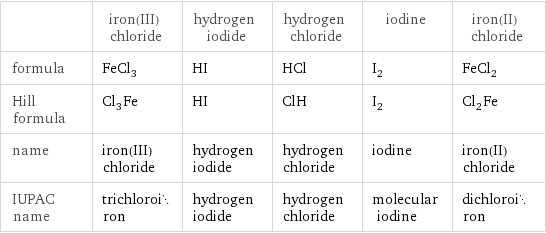
| iron(III) chloride | hydrogen iodide | hydrogen chloride | iodine | iron(II) chloride formula | FeCl_3 | HI | HCl | I_2 | FeCl_2 Hill formula | Cl_3Fe | HI | ClH | I_2 | Cl_2Fe name | iron(III) chloride | hydrogen iodide | hydrogen chloride | iodine | iron(II) chloride IUPAC name | trichloroiron | hydrogen iodide | hydrogen chloride | molecular iodine | dichloroiron
Substance properties
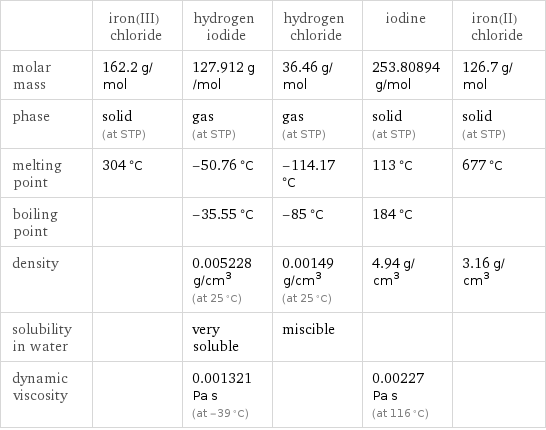
| iron(III) chloride | hydrogen iodide | hydrogen chloride | iodine | iron(II) chloride molar mass | 162.2 g/mol | 127.912 g/mol | 36.46 g/mol | 253.80894 g/mol | 126.7 g/mol phase | solid (at STP) | gas (at STP) | gas (at STP) | solid (at STP) | solid (at STP) melting point | 304 °C | -50.76 °C | -114.17 °C | 113 °C | 677 °C boiling point | | -35.55 °C | -85 °C | 184 °C | density | | 0.005228 g/cm^3 (at 25 °C) | 0.00149 g/cm^3 (at 25 °C) | 4.94 g/cm^3 | 3.16 g/cm^3 solubility in water | | very soluble | miscible | | dynamic viscosity | | 0.001321 Pa s (at -39 °C) | | 0.00227 Pa s (at 116 °C) |
Units
